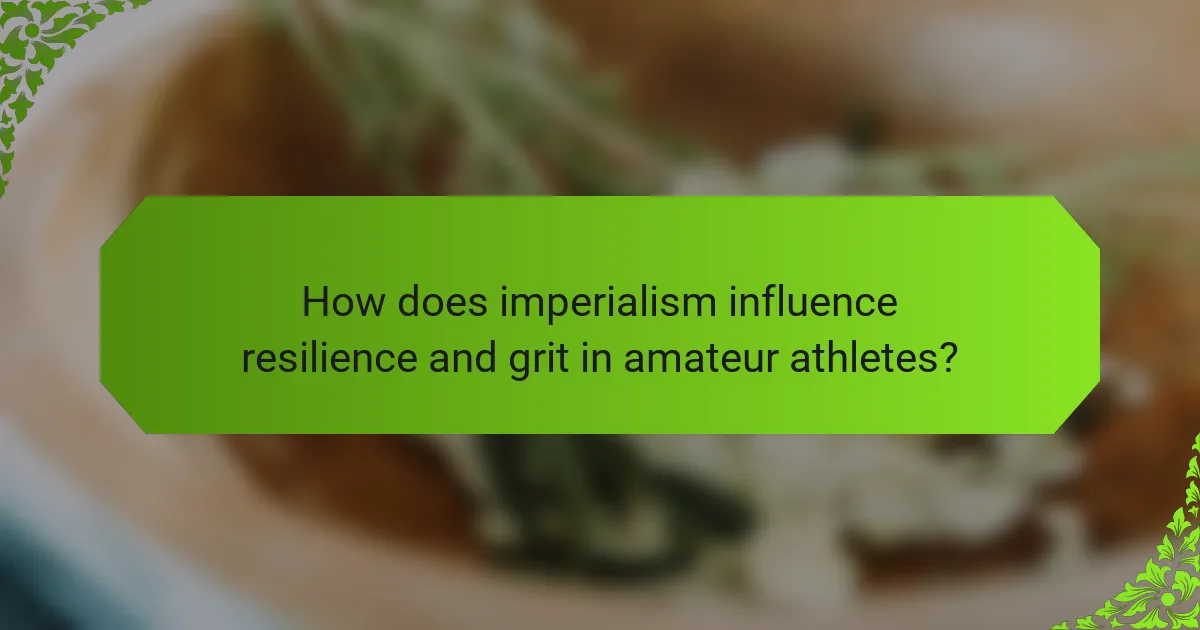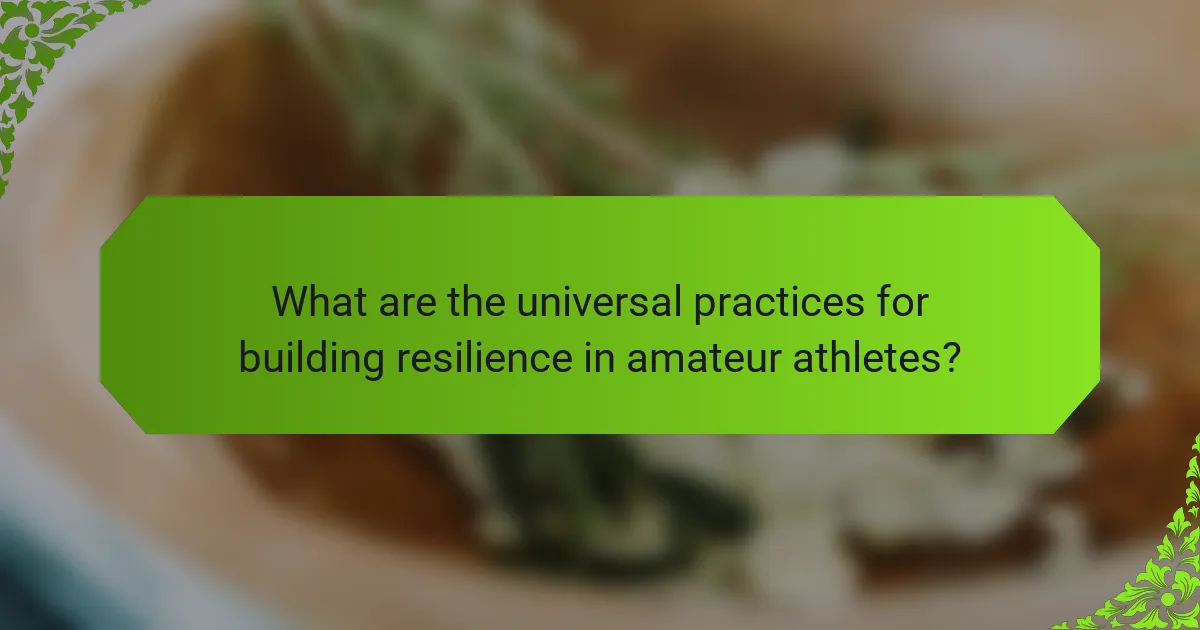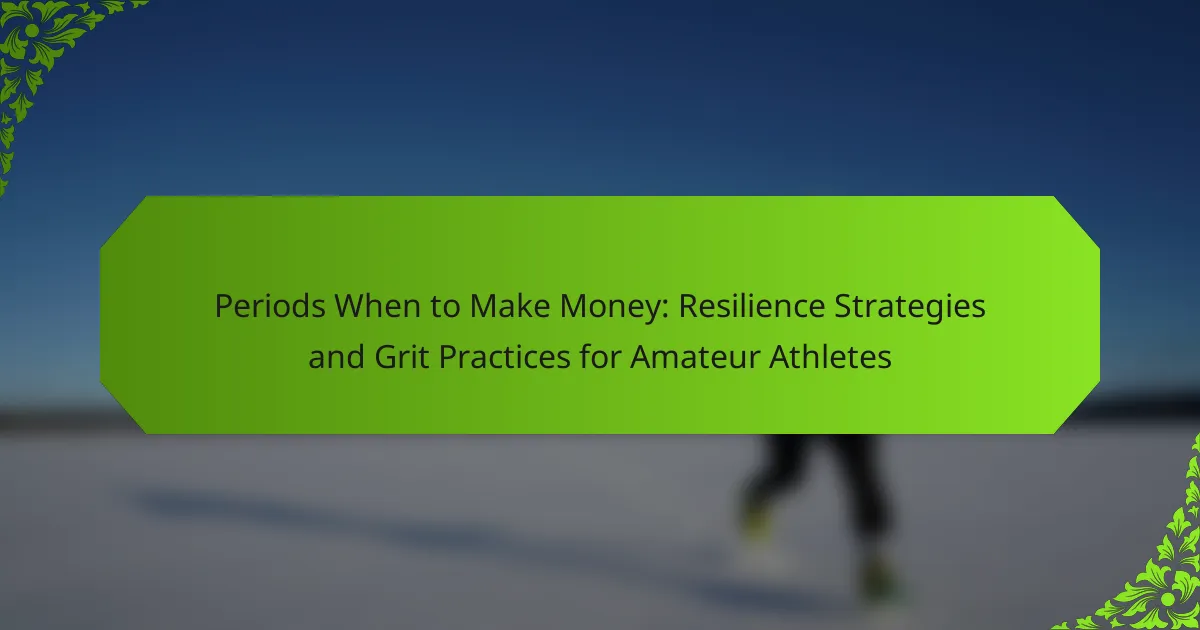Building resilience and grit is crucial for amateur athletes facing challenges in competitive sports. Imperialism shapes their social environments, influencing coping mechanisms and mental toughness. Consistent training, mental conditioning, and supportive communities enhance these traits. Personal beliefs further motivate athletes, fostering a sense of purpose and adaptability in overcoming adversity.

How does imperialism influence resilience and grit in amateur athletes?
Imperialism influences resilience and grit in amateur athletes by shaping their social and cultural environments. It creates challenges that require athletes to adapt, fostering mental toughness. Historical contexts show that athletes from colonised regions often develop strong coping mechanisms to overcome adversity. These experiences build resilience, which is essential for competitive sports. Additionally, the varying beliefs and values imposed by imperialism can motivate athletes to strive for excellence, enhancing their grit.
What are the historical contexts of imperialism affecting sports?
Imperialism significantly influenced sports by promoting cultural exchange and competition. Colonised regions often adopted sports from imperial powers, which shaped local identities and social structures. For example, British colonialism introduced cricket in India, fostering national pride and unity. Additionally, imperialism created disparities in access to sports resources, affecting athlete development. The legacy of these historical contexts continues to impact amateur sports, as cultural beliefs and resilience shape athletes’ experiences and performance.
How do cultural beliefs shape athletic perseverance?
Cultural beliefs significantly influence athletic perseverance by instilling values of resilience and grit. These beliefs shape athletes’ mindsets, motivating them to overcome challenges. For instance, collectivist cultures often emphasise community support, encouraging athletes to persist through hardships. In contrast, individualistic cultures may foster a personal sense of responsibility, driving athletes to push their limits. Additionally, religious beliefs can provide a moral framework, reinforcing the notion of perseverance as a virtue. Understanding these cultural dynamics is essential for coaches and trainers in fostering an environment that promotes sustained effort among amateur athletes.
What are examples of resilience in different cultures?
Resilience manifests in various cultures through distinct practices and beliefs. For example, Indigenous cultures often emphasise community support and connection to nature, fostering resilience through shared experiences. In Asian cultures, practices like meditation and mindfulness promote mental resilience, helping individuals cope with stress. African cultures frequently highlight storytelling and oral traditions as a means to build emotional strength and perseverance. Western cultures may focus on individualism and personal achievement, encouraging resilience through self-reliance and goal-setting. Each cultural approach offers unique insights into developing grit among amateur athletes.

What are the universal practices for building resilience in amateur athletes?
To build resilience in amateur athletes, focus on consistent training, mental conditioning, and supportive environments. These practices enhance grit and perseverance, crucial for overcoming challenges.
First, establish a structured training regimen. Consistency in workouts builds physical endurance and mental toughness. Incorporate varied exercises to prevent monotony and promote adaptability.
Next, emphasise mental conditioning. Techniques such as visualization and mindfulness can help athletes manage stress and maintain focus during competition. These practices foster a growth mindset, essential for resilience.
Lastly, create supportive environments. Encouragement from coaches, peers, and family strengthens athletes’ confidence. Positive reinforcement and constructive feedback contribute to a sense of belonging and motivation.
By integrating these strategies, amateur athletes can cultivate resilience and grit, essential for their development and success in sports.
How do goal-setting techniques enhance grit?
Goal-setting techniques significantly enhance grit by providing clear direction and measurable objectives. These techniques foster resilience in amateur athletes by promoting a growth mindset. Specific, challenging goals encourage persistence and focus, making athletes more likely to overcome setbacks. Research shows that athletes who set goals are more committed and display higher levels of perseverance. This commitment directly correlates with improved performance and mental toughness, essential components of grit.
What role does community support play in developing resilience?
Community support significantly enhances resilience in amateur athletes by providing emotional encouragement, practical resources, and a sense of belonging. This support fosters grit, enabling athletes to overcome challenges and persist in their training. Studies show that social networks can influence mental toughness, with athletes reporting higher resilience levels when they feel supported by their communities. Additionally, shared experiences within a supportive environment can cultivate motivation and accountability, further reinforcing an athlete’s commitment to their goals.
What are effective team-building exercises?
Effective team-building exercises enhance collaboration and resilience in amateur athletes. Activities like trust falls, group challenges, and problem-solving tasks foster communication and grit. Incorporating diverse exercises can strengthen relationships and improve performance. Regular engagement in these activities builds a supportive environment, crucial for athlete development.
How can mental conditioning improve performance?
Mental conditioning significantly enhances performance by fostering resilience and grit in amateur athletes. This process involves mental strategies that improve focus, emotional control, and motivation. For instance, visualization techniques help athletes mentally rehearse their performances, leading to increased confidence and reduced anxiety.
Moreover, adopting a growth mindset encourages athletes to view challenges as opportunities for growth, enhancing their perseverance. Research indicates that athletes who engage in mental conditioning exhibit improved performance metrics, such as faster recovery times and better stress management.
Incorporating mindfulness practices can further support mental conditioning. These practices enhance self-awareness and concentration, enabling athletes to remain present during competition. As a result, athletes can perform at their best, even under pressure.

What unique resilience strategies can amateur athletes adopt?
Amateur athletes can adopt unique resilience strategies such as mental conditioning, community support, and goal setting. Mental conditioning enhances focus and stress management, allowing athletes to perform under pressure. Community support fosters a sense of belonging and motivation, essential for overcoming challenges. Goal setting provides clear benchmarks, promoting accountability and progress tracking. These strategies build grit, enabling athletes to navigate setbacks and maintain commitment.
How does visualization impact athletic performance?
Visualization significantly enhances athletic performance by improving focus, motivation, and mental resilience. Athletes who practice visualization techniques report increased confidence and better execution of skills. Research indicates that mental imagery can activate similar brain regions as physical practice, leading to improved muscle memory and coordination. Additionally, visualization fosters a strong mental framework, allowing athletes to overcome challenges and setbacks. This mental preparation is essential for building resilience and grit, particularly in amateur athletes facing competitive pressures.
What are the benefits of journaling for athletes?
Journaling enhances resilience and grit in amateur athletes by promoting self-reflection and emotional processing. It helps athletes identify strengths and weaknesses, fostering a growth mindset. Regular journaling can improve focus and reduce anxiety, leading to better performance. Additionally, it provides a platform for goal setting and tracking progress, which reinforces commitment and motivation.
What should be included in an athlete’s resilience journal?
An athlete’s resilience journal should include reflections on challenges faced, coping strategies, progress tracking, motivational quotes, and personal goals. These elements foster mental toughness and adaptability.
| Component | Description |
|————————|————————————————–|
| Challenges | Document specific obstacles encountered. |
| Coping Strategies | List techniques used to overcome difficulties. |
| Progress Tracking | Record improvements and setbacks. |
| Motivational Quotes | Include inspiring quotes for encouragement. |
| Personal Goals | Set and revise short- and long-term objectives. |

What rare practices contribute to exceptional grit in athletes?
Exceptional grit in athletes often stems from rare practices that cultivate resilience. These include immersive mental conditioning, unconventional training environments, and community-based support systems. Immersive mental conditioning involves visualization techniques that enhance focus and performance under pressure. Unconventional training environments, such as extreme weather conditions, build adaptability and toughness. Community-based support systems foster a sense of belonging, encouraging athletes to push through challenges together. These practices uniquely contribute to developing exceptional grit, setting athletes apart in their endeavors.
How can unconventional training methods foster resilience?
Unconventional training methods can significantly enhance resilience in amateur athletes by fostering adaptability and mental toughness. These methods often challenge traditional approaches, encouraging athletes to face unique obstacles. For example, incorporating obstacle courses or team-building exercises cultivates problem-solving skills and teamwork. As a result, athletes develop grit by learning to overcome failures and setbacks, ultimately improving performance under pressure. Unique attributes of these methods include promoting creativity in training and enhancing emotional regulation, which are essential for sustaining motivation and focus during competitions.
What is the significance of storytelling in building grit?
Storytelling is significant in building grit as it fosters emotional resilience and connection. Through narratives, amateur athletes can relate personal struggles to broader themes, enhancing their determination. Engaging stories provide context, enabling athletes to visualize overcoming challenges. This process cultivates a mindset that embraces adversity, ultimately reinforcing their grit.

How do personal beliefs influence an athlete’s resilience journey?
Personal beliefs significantly shape an athlete’s resilience journey by influencing their motivation and coping strategies. Strong convictions can instill a sense of purpose, driving athletes to overcome challenges. For instance, beliefs about hard work and persistence can enhance grit, leading to improved performance under pressure. Additionally, faith-based values often provide emotional support, fostering a community that encourages resilience. Athletes who align their training with personal beliefs tend to exhibit greater mental fortitude and adaptability in the face of adversity.
What role do religious beliefs play in athletic perseverance?
Religious beliefs can significantly enhance athletic perseverance by providing a sense of purpose and community. Many athletes draw strength from their faith, which fosters resilience during challenging times. For example, the practice of prayer or meditation can improve mental focus and reduce anxiety. Studies indicate that athletes who integrate their beliefs into training exhibit greater grit and determination. This unique attribute of faith-based motivation often leads to improved performance and sustained commitment in amateur sports.
How can athletes reconcile differing opinions on training methods?
Athletes can reconcile differing opinions on training methods by fostering open communication and collaboration. Engaging in discussions allows athletes to share experiences and insights, which enhances understanding of various training philosophies.
Establishing a common goal is vital; focusing on shared objectives promotes unity despite differing views. Athletes should remain open-minded and willing to adapt their methods based on peer feedback, which cultivates resilience and grit.
Utilising evidence-based practices can help validate training methods. Athletes can analyse performance metrics to determine the effectiveness of various approaches, ensuring decisions are informed and objective.
Regularly reassessing training strategies encourages flexibility and growth. Athletes who embrace change are more likely to thrive in dynamic environments, ultimately enhancing their performance.

What actionable tips can amateur athletes implement to enhance their resilience?
Amateur athletes can enhance their resilience through consistent practice, mental conditioning, and community support. Developing a growth mindset allows athletes to embrace challenges and learn from setbacks. Setting realistic goals fosters motivation and focus. Engaging in mindfulness techniques can improve emotional regulation and stress management. Building a supportive network provides encouragement and accountability, reinforcing perseverance in the face of adversity.
What are the common mistakes to avoid in building grit?
Common mistakes in building grit include setting unrealistic goals, neglecting mental health, and lacking consistency. Amateur athletes often underestimate the importance of a supportive environment and fail to embrace failure as a learning opportunity. Additionally, they may focus too much on outcomes rather than the process, leading to burnout. Recognising these pitfalls is crucial for developing resilience and sustaining motivation.
What expert insights can guide athletes in their resilience practices?
Athletes can enhance resilience by adopting mental strategies, consistent training, and supportive environments. Expert insights suggest focusing on goal-setting, positive self-talk, and developing a growth mindset. Research highlights that resilience is built through overcoming challenges, fostering grit, and maintaining strong social connections.


